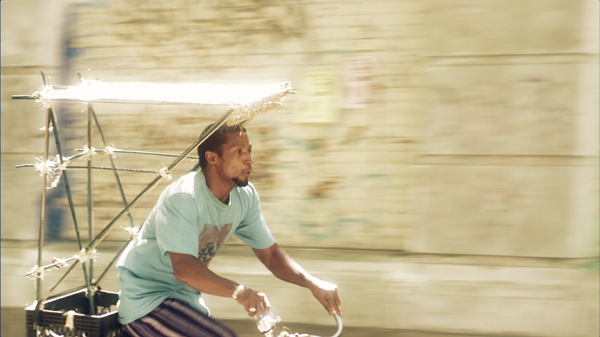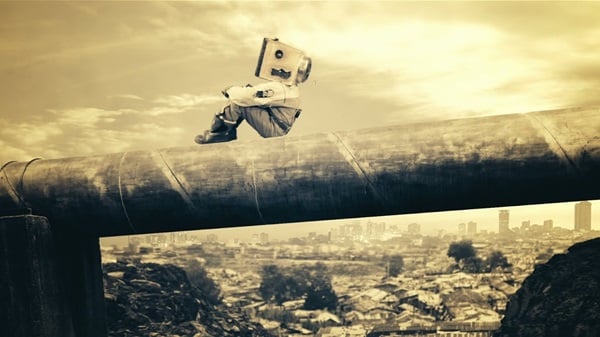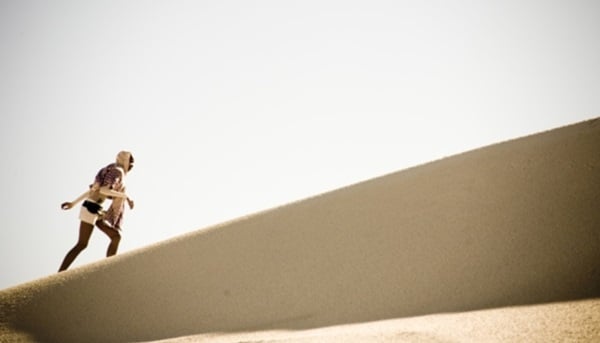Art & Exhibitions
Telling the Story of the African Diaspora Through Sci-Fi
“a/wake in the water” uses an unexpected form to tell an urgent story.

“a/wake in the water” uses an unexpected form to tell an urgent story.

Bansie Vasvani

“a/wake in the water: Meditations on Disaster” opened at the Museum of Contemporary African Diasporan Arts (MoCADA) in Fort Greene, Brooklyn with a moment of silence in memory of the hardships faced by the African-American community. The somber tone set the mood for the thought-provoking group exhibition featuring 10 artists who use video, film, and multimedia to examine the effects of current and future environmental calamities on people of African origin.
The show is curated by Erin Christovale, and the diverse cinematic techniques used by the show’s various artists are united by the way they employ the imagery of science fiction to address, in Christovale’s words, “how Black bodies experience environmental hazards.” The films’ urgency comes from the way the sci-fi conceit allows artists to present the power structures, economic conditions, and social dynamics impacting the African community in ways both accessible and estranging.
For instance, in Berlin-based Loretta Fahrenholz’s 31-minute Ditch Plains (2013), shot in post-Sandy terrain in East New York, street dancers from the Ringmasters Crew, their bodies decorated by electroluminescent strips, move disjointedly through the decayed urban environment, improvising Stop and Frisk scenarios and vignettes that suggest catastrophe and death. The film is accompanied by an often indecipherable voiceover, and intercut with real shots from post-hurricane Far Rockaway of police patrols and chaos, blurring the distinction between real and imagined terror.

Muchiri Njenga, Kichwateli (2011)
Photo: Courtesy of Studio Ang
Works presented by Muchiri Njenga and Wanuri Kahiu, both artists from Kenya, have a similar ominous atmosphere. Set to electronic music in a post-apocalyptic, sepia-toned Africa, Njenga’s expertly shot eight-minute phantasmagoria, Kichwateli (2011), follows a young boy from the Nairobi slums whose encounter with the big city triggers a fantastic transformation: His head morphs into a television screen, streaming news of captivity, abduction, and other topical nightmares. The boy is shown eliciting horror and repulsion from the slums he passed through, as their squalid living conditions are juxtaposed with the barrage of media imagery pouring out of the boy’s head, a surrealist personification of the clash of modernity.

Wanuri Kahiu, Pumzi (2010)
Photo: Courtesy of Swank Productions
In Kahiu’s dystopic 22-minute Pumzi (2010) (the word means “breathe” in Swahili), the action is set 35 years after WWIII, in a world where residents reside in a spaceship-like vehicle to gain protection from the radioactive East African desert around them. The intricate story has Asha the botanist struggle and eventually escape from the oppressive environment of the ship, characterized by medically suppressed dreams and the consumption of recycled human sweat and urine. Her ultimate goal—to plant a seed in the barren landscape—stands as a simple but bleak metaphor for the future of a continent deprived of resources.

A. Sayeeda Clarke, WHITE (2011)
Photo: Courtesy of the artist
Dystopia is also used as a tool to showcase the intersection of race, class, and politics in another highlight: New York–based Sayeeda Clarke’s 16-minute film White (2011). It depicts a futuristic scorching New York City that clocks 120-degree heat five days before Christmas. As a consequence of the transformed climate, melanin has become the currency of the day, and the struggling Black hero sells the melanin in his skin to pay for his child’s birth. The dynamics of racial hierarchy are reversed when Blackness becomes wealth—though familiar hardships, evidently, have a long afterlife.
Ultimately, despite such fanciful trappings, the selection of works in “a/wake in the water: Meditations on Disaster” provokes reflections on a series of grim themes: lack of development, environmental hardship, lasting imbalance of power. Nevertheless, by presenting the future through this lens, these works of art also serve as a wake-up call, serving perhaps as the first step towards change.
“a/wake in the water: Meditations on Disaster” is on view at the Museum of Contemporary African Diasporan Arts through November 9, 2014.